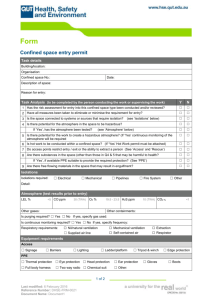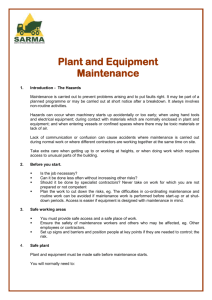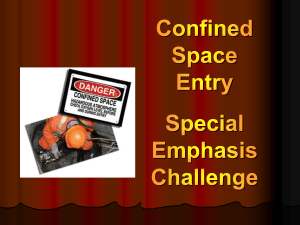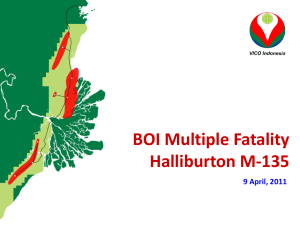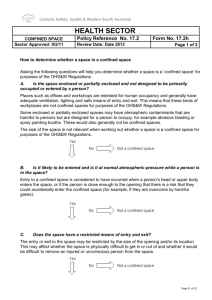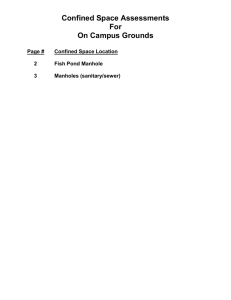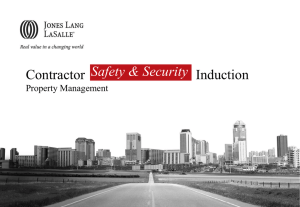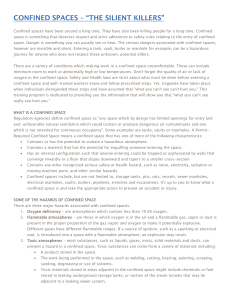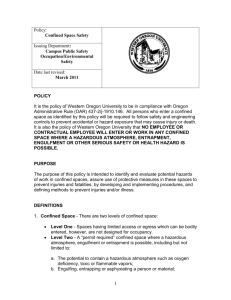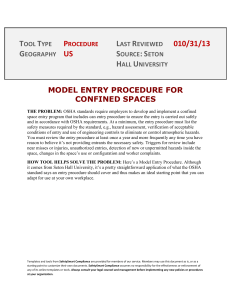hazardous atmospheric
advertisement
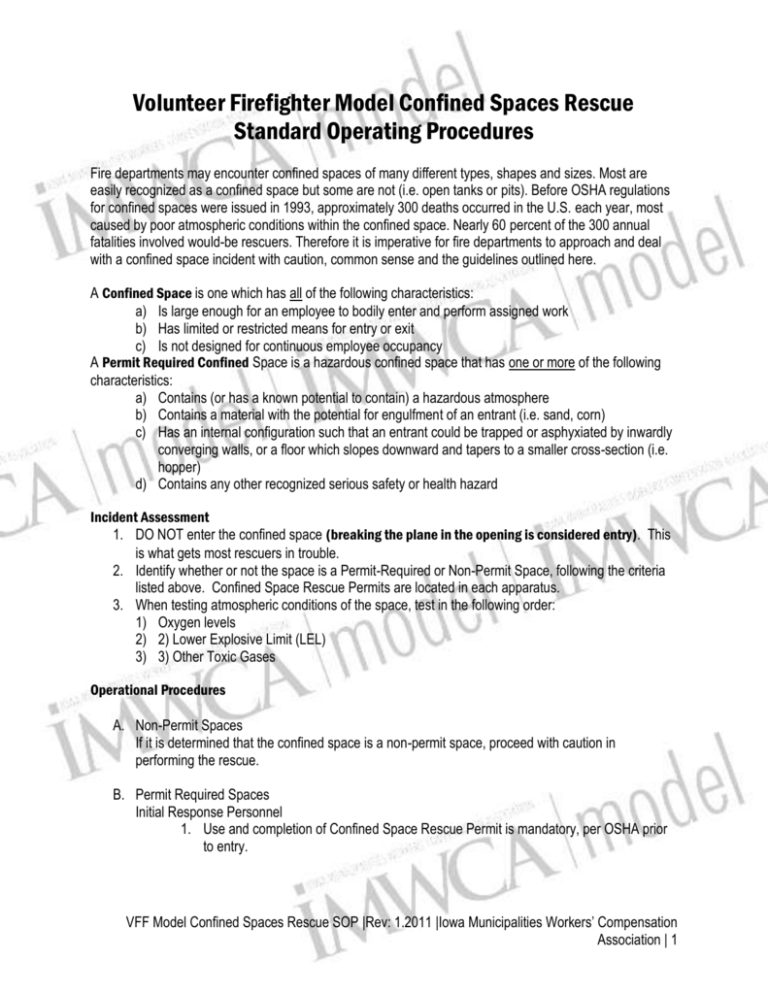
Volunteer Firefighter Model Confined Spaces Rescue Standard Operating Procedures Fire departments may encounter confined spaces of many different types, shapes and sizes. Most are easily recognized as a confined space but some are not (i.e. open tanks or pits). Before OSHA regulations for confined spaces were issued in 1993, approximately 300 deaths occurred in the U.S. each year, most caused by poor atmospheric conditions within the confined space. Nearly 60 percent of the 300 annual fatalities involved would-be rescuers. Therefore it is imperative for fire departments to approach and deal with a confined space incident with caution, common sense and the guidelines outlined here. A Confined Space is one which has all of the following characteristics: a) Is large enough for an employee to bodily enter and perform assigned work b) Has limited or restricted means for entry or exit c) Is not designed for continuous employee occupancy A Permit Required Confined Space is a hazardous confined space that has one or more of the following characteristics: a) Contains (or has a known potential to contain) a hazardous atmosphere b) Contains a material with the potential for engulfment of an entrant (i.e. sand, corn) c) Has an internal configuration such that an entrant could be trapped or asphyxiated by inwardly converging walls, or a floor which slopes downward and tapers to a smaller cross-section (i.e. hopper) d) Contains any other recognized serious safety or health hazard Incident Assessment 1. DO NOT enter the confined space (breaking the plane in the opening is considered entry). This is what gets most rescuers in trouble. 2. Identify whether or not the space is a Permit-Required or Non-Permit Space, following the criteria listed above. Confined Space Rescue Permits are located in each apparatus. 3. When testing atmospheric conditions of the space, test in the following order: 1) Oxygen levels 2) 2) Lower Explosive Limit (LEL) 3) 3) Other Toxic Gases Operational Procedures A. Non-Permit Spaces If it is determined that the confined space is a non-permit space, proceed with caution in performing the rescue. B. Permit Required Spaces Initial Response Personnel 1. Use and completion of Confined Space Rescue Permit is mandatory, per OSHA prior to entry. VFF Model Confined Spaces Rescue SOP |Rev: 1.2011 |Iowa Municipalities Workers’ Compensation Association | 1 2. 3. 4. 5. 6. 7. 8. a. Use the Permit as both a guide and checklist to assist with walking you through the procedures necessary to safely and effectively handle a confined space rescue. Obtain the confined space Entry Permit. This is the permit that the contractor should have had to work in the space. Review Confined Space Pre-Incident Plan if available. ( Based on annual review and mock rescue) Contact attendant/entry supervisor. Limit access to the area. Establish control zones a. Hot: 100’ around access point b. Warm: an additional 100’ c. Cold: an additional 100’ Attempt to find out as much victim information as possible. a. Number of victims b. How long they have been unaccounted for. c. Their specific location inside if possible. d. What type of protection i.e. half mask, supplied air respirators? Identify the confined space hazards. a. Determine if atmospheric hazards exist. Most common hazards include low oxygen levels. b. Testing for atmospheric hazards should be done at several locations. c. Identify other known or possible physical hazards (i.e. sand, grain). Confined Space Rescue I. Rescue / Entry 1. Make the confined space safe for entry (isolate from hazards) a. Atmospheric testing – reading should be every 5 min, must maintain a log of readings. b. Ventilation c. Lock-out / tag-out d. Blocking or blinding e. Disconnect machinery that might cause entanglement or injury. f. Barriers / surrounding area so no one inadvertently falls. 2. Designate Peronnel a. Entrants: Select two entrants, if confined space allows. b. Back-up rescue team: For each primary rescuer there needs to be a back-up rescuer c. Attendant: Monitors the entry into the confined space and stays in communication with the entrants 3. Equipment / PPE a. Respiratory protection: Mandatory use if potentially hazardous atmosphere exists b. Fall protection: Mandatory if over 5 feet deep VFF Model Confined Spaces Rescue SOP |Rev: 1.2011 |Iowa Municipalities Workers’ Compensation Association | 2 c. Lifelines: Use is mandatory d. Communication equipment: Mandatory between entrants and attendant. 4. Personnel Awareness a. Pre-entry briefing: Includes location/ condition of victims, hazards that exists in the space b. Recorded by Attendant: Time of rescue team entry, monitor air supply levels, monitor fatigue level. c. Maintain log on atmospheric testing 5. Authorization a. Before entry is made: The supervisor must sign-off on the permit that all necessary steps have been taken to make safe entry b. After the incident The Permit needs to be filed with the HSO who will store the records for one year. VFF Model Confined Spaces Rescue SOP |Rev: 1.2011 |Iowa Municipalities Workers’ Compensation Association | 3

